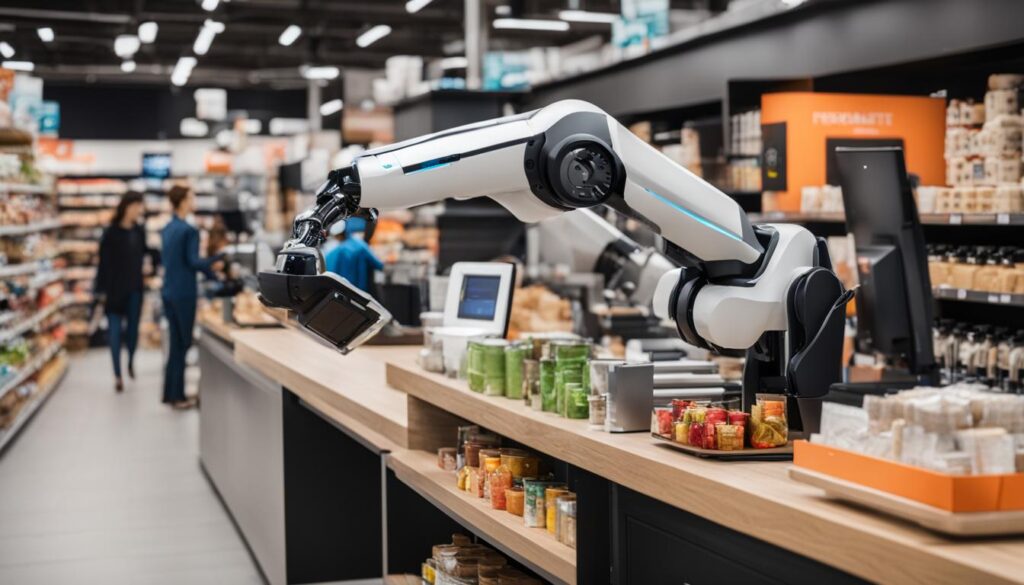Welcome to our article on the role of Robotic Process Automation (RPA) in the midst of other emerging technologies. As businesses continue to embrace digital transformation, automation technology has become a vital component for ensuring operational efficiency and staying ahead of the competition. RPA, powered by artificial intelligence, machine learning, and robotics, is a key player in this landscape.
RPA has evolved into Intelligent Process Automation (IPA), integrating technologies such as Natural Language Processing (NLP) to enable advanced automation capabilities. With the RPA market projected to reach $22 billion by 2025, organizations across industries are realizing the potential of RPA in streamlining processes and driving innovation.
As we explore where RPA fits in with other emerging technologies, we’ll delve into its applications in various sectors, including interactive chatbots, retail, finance, and more. We’ll uncover how RPA can enhance customer experiences, streamline operations, improve efficiency, and generate valuable data insights.
To better understand the role of RPA in the digital landscape and its potential impact on your organization, let’s dive into the details of implementing RPA amidst emerging tech trends, technology integration, and industry 4.0 advancements.
Contents
- 1 Improving Customer Experience with Interactive Chatbots
- 2 Streamlining Operations in Retail with RPA
- 3 Enhancing Efficiency in Finance with RPA
- 4 Conclusion
- 5 FAQ
- 5.1 Where does RPA fit in with other emerging technologies?
- 5.2 How does RPA improve customer experience with interactive chatbots?
- 5.3 How does RPA streamline operations in the retail industry?
- 5.4 How does RPA enhance efficiency in the finance industry?
- 5.5 What are the benefits of RPA in digital transformation?
- 6 Source Links
Key Takeaways:
- RPA is a pivotal technology in digital transformation, aligning with emerging technologies like AI, ML, and robotics.
- RPA can improve customer experience through interactive chatbots and enhance operational efficiency in various industries.
- In retail, RPA streamlines operations, improves inventory management, and optimizes logistics and supply chain management.
- In finance, RPA automates tasks, reduces errors, and improves data quality.
- Implementing RPA enables organizations to achieve scalability, cost savings, and valuable data insights and analytics.
Improving Customer Experience with Interactive Chatbots
RPA and Conversational AI play a vital role in enhancing customer engagement and employee engagement, leading to improved customer experiences and increased operational efficiency. Organizations like AIG Israel have successfully implemented RPA systems to automate customer services, resulting in quicker and more efficient customer service.
With the integration of RPA and Conversational AI, organizations can automate various customer engagement tasks, such as ordering, application processing, customer onboarding, and claims processing. This automation not only streamlines the customer journey but also frees up valuable time for employees to focus on higher-value tasks.
For instance, through the implementation of RPA, customer service representatives can rely on interactive chatbots to handle repetitive tasks and provide immediate assistance to customers. These chatbots can efficiently address common customer queries, offer personalized recommendations, and even initiate actions based on customer preferences. Such automation not only improves customer satisfaction but also contributes to faster query resolution and increased overall customer engagement.
RPA’s benefits extend beyond customer engagement to employee engagement as well. By automating tasks like recruitment, payroll, and benefits management, organizations can enhance employee experiences and reduce administrative burden. This allows employees to focus on meaningful work that drives innovation and business growth.
As the demands of customer service continue to evolve, interactive chatbots powered by RPA and Conversational AI become indispensable tools for organizations striving to provide exceptional customer experiences. The automation of customer engagement tasks and employee engagement processes through the seamless integration of these technologies enables organizations to deliver efficient, personalized, and engaging interactions with customers while optimizing operational workflows.
| Benefits of Interactive Chatbots and RPA in Customer Service | Benefits of Interactive Chatbots and RPA in Employee Engagement |
|---|---|
|
|
Implementing interactive chatbots powered by RPA and Conversational AI in customer service and employee engagement can transform the way organizations interact with their customers and empower their employees to deliver exceptional experiences.
Streamlining Operations in Retail with RPA
Retail giant Walmart has recognized the tremendous potential of Robotic Process Automation (RPA) in optimizing its operations. By leveraging RPA technology, Walmart has successfully automated various tasks, such as answering employee queries, tracking inventory flow, and identifying slow-moving items. The implementation of RPA has not only improved operational efficiency but has also had a positive impact on inventory management, logistics, and supply chain management in the retail industry.
RPA offers numerous benefits when applied to retail operations. By automating inventory management processes, retailers can ensure more accurate stock levels, reducing the risk of stockouts and overstocking. This, in turn, results in improved product availability and customer satisfaction. Furthermore, RPA can automate product categorization, allowing retailers to streamline the organization and classification of their inventory, making it easier to locate and manage specific products.
RPA also proves advantageous in enhancing logistics and supply chain management. With RPA, retailers can automate manual tasks such as order processing, invoice generation, and shipment tracking. Automation reduces errors and improves efficiency, resulting in smoother and faster logistical operations. By streamlining supply chain management processes, retailers can better monitor and optimize inventory levels, reducing costs and improving overall operational performance.

Moreover, RPA enables retail organizations to gain valuable insights into consumer behavior by automating the analysis of customer data. Through advanced data analytics, retailers can identify trends, preferences, and patterns, allowing them to make data-driven business decisions and tailor their marketing strategies accordingly. This drives customer engagement and increases sales opportunities.
In summary, the integration of RPA in the retail industry offers vast improvements across inventory management, logistics and supply chain management, and overall operational efficiency. By embracing RPA technology, retailers can enhance product availability, reduce errors, streamline operations, and ultimately provide an exceptional shopping experience for their customers.
Enhancing Efficiency in Finance with RPA
RPA, or Robotic Process Automation, has emerged as a game-changer in the finance industry. By implementing RPA, financial organizations can automate a range of tasks, including the generation of invoices, tracking payments, processing orders, and streamlining payment approvals. This technology has revolutionized financial services by eliminating manual data entry, reducing errors, and improving data quality.
One such example of RPA in finance is the partnership between Pegasystems and Bank of America. They have successfully implemented Pega Robotic Automation, a cutting-edge RPA solution, to automate data-intensive processes in transaction execution and exception handling. This automation has resulted in increased efficiency and accuracy, helping Bank of America deliver exceptional customer service and enhance operational effectiveness.
Automating Payment Approvals
RPA has proven to be particularly beneficial in automating payment approvals. Manual payment approval processes can be time-consuming and prone to errors. By leveraging RPA, organizations can automate this entire workflow, from verifying the payment request to validating the payment details and approving the transaction. This not only speeds up the payment approval process but also ensures compliance and accuracy in financial transactions.
Improving Data Quality
Data quality is of utmost importance in the finance industry. Manual data entry can be error-prone and lead to costly mistakes. However, with RPA, financial organizations can automate data entry, ensuring consistency and accuracy. By reducing manual intervention, RPA minimizes the risk of data errors and enhances data quality. This, in turn, enables organizations to make informed decisions based on reliable data.
“RPA has revolutionized financial services by eliminating manual data entry, reducing errors, and improving data quality.”
Moreover, RPA in finance enables seamless integration with existing systems and applications, allowing financial institutions to maximize their legacy infrastructure investment. By automating processes, organizations can free up valuable resources and redirect them to more strategic initiatives that drive business growth.

RPA has undeniably transformed the finance industry, enhancing operational efficiency, reducing costs, and improving customer satisfaction. Financial institutions that embrace RPA gain a competitive edge by speeding up processes, improving data accuracy, and delivering a superior customer experience. With its potential to revolutionize the way financial services are delivered, RPA continues to be a driving force behind digital transformation in the finance industry.
Conclusion
RPA, also known as Robotic Process Automation, plays a pivotal role in digital transformation. By automating repetitive tasks, RPA enhances operational efficiency, streamlines processes, and improves the overall customer experience. It enables organizations to ensure data accuracy and compliance while providing valuable data insights and analytics.
One of the key benefits of RPA is its scalability. As businesses grow and evolve, RPA can easily adapt to meet the increasing demands. This scalability feature allows organizations to handle larger workloads without compromising efficiency, ultimately driving business growth.
Implementing RPA also brings significant cost savings. By automating tasks that were previously performed manually, organizations can reduce labor costs and minimize errors. This leads to greater productivity and ultimately contributes to the bottom line.
Furthermore, RPA empowers employees to focus on higher-value work and innovation. By automating mundane and repetitive tasks, RPA frees up time for employees to engage in strategic initiatives and creative problem-solving. This not only boosts employee satisfaction but also drives business agility and competitiveness.
FAQ
Where does RPA fit in with other emerging technologies?
RPA intersects with emerging technologies like artificial intelligence, machine learning, and robotics in various applications such as customer engagement, employee engagement, retail, finance, and more.
How does RPA improve customer experience with interactive chatbots?
RPA and conversational AI intersect in customer engagement, allowing organizations to automate tasks like customer service, ordering, onboarding, and claims processing, leading to quicker and more efficient customer service.
How does RPA streamline operations in the retail industry?
RPA can automate functions like inventory management, product categorization, logistics and supply chain management, and consumer behavior analysis, enabling retailers to improve product availability, reduce errors, and streamline operations.
How does RPA enhance efficiency in the finance industry?
RPA is used in financial services to automate tasks like generating invoices, tracking payments, and processing orders. By implementing RPA, organizations can eliminate manual data entry, reduce errors, and improve data quality.
What are the benefits of RPA in digital transformation?
RPA plays a pivotal role in digital transformation by enhancing operational efficiency, streamlining processes, improving customer experience, ensuring data accuracy and compliance, enabling scalability, generating cost savings, and providing valuable data insights and analytics.




